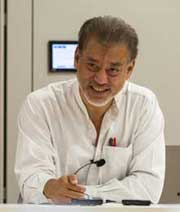CAIRO, Sep 24 (IPS) – Net zero emissions by 2050 prioritizes mitigation for climate stabilization. Pledges to achieve this distant target have grown, but inadvertently delay urgently needed climate action in the short term.
Net zero
The 1992 United Nations Framework Convention on Climate Change (UNFCCC) involved to “the stabilization of greenhouse gas concentrations in the atmosphere at a level that would prevent dangerous anthropogenic interference with the climate system”.

Since the 2021 UNFCCC Conference of Parties (COP) in GlasgowMany governments have pledged to achieve net zero emissions by 2050, which is seen as achieving climate stabilization.
After failing to meet several other commitments made in Glasgow, such as ending the burning of coal for energy, the G7 Western leaders have piously repeated the ‘Net zero by 2050’ pledge in April 2024.
The Net Zero target aims to halt further accumulation of greenhouse gas emissions by mid-century. Net Zero therefore requires reducing greenhouse gas emissions and accumulation well before the end of the century in 2100, the previous target year.
Worse, the agreement allows for remarkable exemptions that are hardly trivial. Calculations of greenhouse gas emissions rule out exemptions, for example for military purposes, air and sea transport. The US alone accounts for a trillion dollars, or two-fifths of the world’s military expenditure of about $2.5 trillion per year.
Meanwhile, some developing countries, invoking the principle of ‘common but differentiated responsibilities’ (CBDR), have negotiated for more time, for example: India has announced a deadline of 2070.
Nice slogan, but not enough
The Intergovernmental Panel on Climate Change (IPCC) Special ReportThe aim of keeping warming below 1.5°C was used to argue for the 2050 net zero target.
Net zero by 2050 offers an attractively simple target for climate stabilization. If fully implemented, net zero should stabilize the climate from 2050 onwards, but it certainly won’t stop global warming in time.
As politicians, leaders have been more willing to make promises that are far into the future. After all, the year 2050 was almost three decades after the Glasgow COP in 2021.
Net zero first appeared at the 2014 UNFCCC conference Emissions Gap Report and at the UNFCCC COP then. World Bank President Jim Kim proclaimed then we must “achieve net zero greenhouse gas emissions by 2100”.
The Paris Agreement of 2015 committed to “implementing rapid reductions… to balance between anthropogenic emissions by sources and removals of greenhouse gases by sinks in the second half of this century”.
The new target year of 2050 is therefore a significant improvement on previous targets, but will not reduce greenhouse gas emissions in time to avoid exceeding the 1.5°C limit.
Net zero wells
Removing greenhouse gases will trap and absorb less heat in the Earth’s atmosphere. Net zero has revived hopes for carbon sinks, with little recognition that most of the impacts of climate change, especially global warming, are largely irreversible.
Many proponents of carbon capture believe that “carbon removal” and “negative emissions” technologies will be sufficient. These include carbon capture and storagetopsoil carbon sequestration, large-scale tree planting and reforestation, with more controversial ‘geo-engineering’ projects announced recently.
The IPCC Special Report warned that while some options are technologically feasible, many have not proven viable on a large scale. There is also no scientific basis for claims that the worst effects of global warming can be reversed.
The revised version of the International Energy Agency Net Zero Roadmap For the 2023 Dubai COP, the UNFCCC led to recommend “Moving away from fossil fuels in energy systems in a just, orderly and equitable manner, and accelerating action in this crucial decade, to achieve net zero by 2050, consistent with science.”
But regardless of the intentions of proponents, mitigation measures have been abused for greenwashing. Emissions Gap Report 2023 noted that the gap between promises and actions has widened.
Some net-zero advocates want to increase the responsibility of the states involved by proposing a new, legally binding agreement to replace the Kyoto Protocol, which was abandoned by most wealthy countries after it was rejected by the US Senate.
Temperature targets
Governments pledged to meet the 2015 Paris Agreement target of keeping global warming below 1.5°C. But the UN Special Envoy for Climate Action and Finance Mark Carney expects the threshold to be exceeded within ten years, well before 2050!
In recent decades, the climate policy debate has shifted from reducing emissions to limiting global warming above pre-industrial levels.
The European Union has the two degrees Celsius (2°C) threshold in 1996, insisting that it should apply to everyone. However, some of the most vulnerable developing countries, mainly in the tropics, have successfully pushed for 1.5°C.
The IPCC argued in 2014 that for warming of less than 2°C “almost zero “to reduce emissions of carbon dioxide and other long-lived greenhouse gases by the end of the century”. Carbon budget Forecasts have improved due to better techniques for monitoring greenhouse gas emissions and atmospheric persistence.
After sustained efforts by some developing countries, led by some of the most vulnerable countries, a later IPCC Special Report urged to keep global warming below 1.5°C. Low-lying island states rallied behind “1.5°C to stay alive“, with many calling for a fossil fuel non-proliferation treaty to phase them out.
IPS UN Office
Follow @IPSNewsUNBureau
Follow IPS News UN Bureau on Instagram
© Inter Press Service (2024) — All rights reservedOriginal source: Inter Press Service







